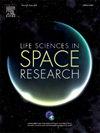在可能的载人火星任务中,宇宙辐射暴露对怀孕的影响。
IF 2.8
3区 生物学
Q2 ASTRONOMY & ASTROPHYSICS
引用次数: 0
摘要
随着航天工业在探索深空及其对人体的影响方面取得实质性进展,航天任务已经揭示了这种独特环境的某些不利因素,如微重力、宇宙辐射等。银河宇宙辐射(GCR)是电离辐射的一种形式,是具有潜在健康影响的环境因素之一,因此可能限制深空任务的持续时间和可能发生的次数。如果在飞行前不久或飞行期间意外怀孕,航天飞行期间,特别是在探索级任务期间,暴露在高剂量的宇宙辐射中,可能对发育中的胎儿产生致畸作用。本研究旨在探讨孕妇在可能的载人火星任务期间的累积剂量是否可能超过地球上致畸辐射的限制。对提供飞行时间数据和地球与火星之间吸收的宇宙辐射当量的各种研究、技术文件和出版物进行了分析。还设计了一个基于文献的模拟6个月太空飞行妊娠的假设模型,以估计GCR的累积吸收剂量。估计剂量率为90至324毫西弗。假设一名怀孕的机组人员暴露在这个剂量范围内,相当于胚胎/胎儿的总致畸剂量似乎明显高于国家辐射防护委员会(NCRP)和美国核管理委员会(USNRC)的建议,即在怀孕期间的最大辐射剂量为5毫西弗,因此这样的超过剂量可能导致致畸。目前的保护策略可能不足以保护人类基因组免受宇宙辐射的有害影响,在人类殖民火星期间的长期星际旅行中,它们需要得到改进。本文章由计算机程序翻译,如有差异,请以英文原文为准。
The Effects of Cosmic Radiation Exposure on Pregnancy During a Probable Manned Mission to Mars
Space missions have revealed certain disincentive factors of this unique environment, such as microgravity, cosmic radiation, etc., as the aerospace industry has made substantial progress in exploring deep space and its impacts on human body. Galactic cosmic radiation (GCR), a form of ionizing radiation, is one of those environmental factors that has potential health implications and, as a result, may limit the duration – and possibly the occurrence – of deep-space missions. High doses of cosmic radiation exposure during spaceflight, particularly during exploration class missions, may have teratogenic effects on a developing fetus, if an unintended pregnancy occurs shortly before or during the flight. This study aimed to discuss whether the cumulative dosage for a pregnant woman during a probable manned mission to Mars may exceed the terrestrial teratogenic radiation limit. A variety of studies, technical documents, and publications that provided flight duration data and the absorbed cosmic radiation dosage equivalents between Earth and Mars were analyzed. A literature-based hypothetical model of a pregnancy simulation over a 6-month spaceflight was also designed to estimate the cumulative absorbed GCR dose. The estimated dose rates ranged from 90 to 324 mSv. Assuming that a pregnant crew member is exposed to this dosage range, the total teratogenic dose equivalent to the embryo/fetus appear to be significantly higher than that of the National Council on Radiation Protection (NCRP)’s and United States Nuclear Regulatory Commission (USNRC)’s recommendations, which state a maximum radiation dose of 5 mSv for the duration of the pregnancy, and thus such an exceeded dose may likely result in teratogenesis. Current protective strategies may not be sufficient to protect the human genome from the detrimental effects of cosmic radiation, and they need be improved for long-term interplanetary travels during human colonization of Mars.
求助全文
通过发布文献求助,成功后即可免费获取论文全文。
去求助
来源期刊

Life Sciences in Space Research
Agricultural and Biological Sciences-Agricultural and Biological Sciences (miscellaneous)
CiteScore
5.30
自引率
8.00%
发文量
69
期刊介绍:
Life Sciences in Space Research publishes high quality original research and review articles in areas previously covered by the Life Sciences section of COSPAR''s other society journal Advances in Space Research.
Life Sciences in Space Research features an editorial team of top scientists in the space radiation field and guarantees a fast turnaround time from submission to editorial decision.
 求助内容:
求助内容: 应助结果提醒方式:
应助结果提醒方式:


